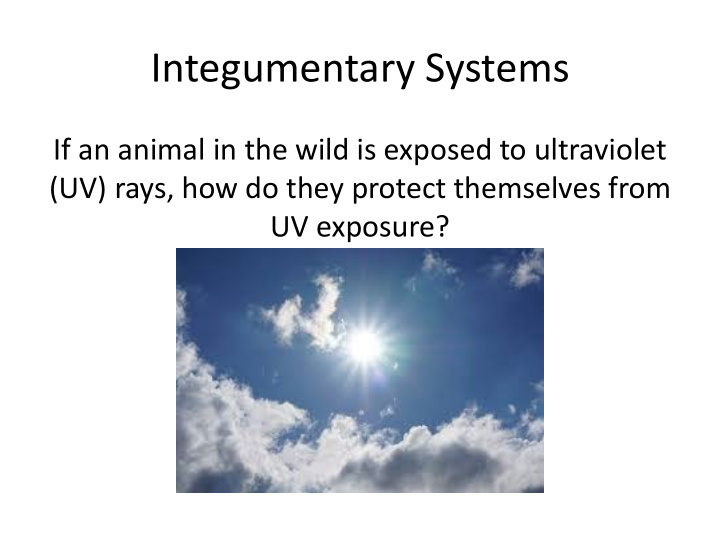



Integumentary Systems If an animal in the wild is exposed to ultraviolet (UV) rays, how do they protect themselves from UV exposure?
Integument and UV Rays
Integumentary System • A external system that protects the internal organs and structures of animals
The Importance of the Integument Protection from • Abrasion • Puncture • Invasive bacteria • desiccation • water saturation • UV rays
Key organ of the human integumentary system: • The skin; made up of: – epidermis: a single- layered outermost tissue – dermis- the inner layer that contains follicles, sweat glands, muscles, nerves, and blood vessels
The integumentary system may also provide additional protection in the form of: • Exoskeleton (found in arthropods) • Hair or fur • Feathers • Scales (in reptiles and fish) • Pigments • Structural Coloration
Exoskeleton • Found in arthropods such as insects and crustaceans • A two-layered complex cuticle • A non-cellular material secreted by the epidermis
Hair or fur • Found in mammals • Originates from the epidermis • A thread-like protein composed of keratin • Found in a range of earth-tone colors (brown, black, red, or yellow)
Feathers • Found in birds • Originates from the epidermis • A highly branched structure composed of keratin • One of the most complex integumentary systems in the biological world
Scales • Found in reptiles, fish, butterflies and moths wings, the feet of birds • Originates from the epidermis • Small rigid plates of protein composed of keratin • Found in a range of sizes and colors
Pigment • Large molecules that reflect light • The most common melanin is a group of black or brown colors • Melanin can range from yellow and to red in color • Produced by special cells in the epidermis
Structural Coloration • Found in butterflies, certain beetles, and a few fish • They can reflect light • They give off iridescent and metallic hues • Found in the cuticle or scale • Composed of several stacks of plate-like structures
Why is UV protection important? Sunlight plays a key role in synthesizing vitamin D in the human body; however, overexposure to UV rays over time can: • Age the skin prematurely • Cause the skin to become dry and leathery • In high doses, it can cause genetic mutations • Cause skin cancer – 1 million new cases of skin cancer occur in humans each year
Recommend
More recommend